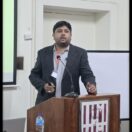Published in worldbank.org
“The priestly leaders of the Parsis were brought before the local ruler, Jadhav Rana, who presented them with a vessel full of milk to signify that the surrounding lands could not possibly accommodate any more people. The Parsi head priest responded by slipping some sugar into the milk to signify how the strangers would enrich the local community without displacing them. They would dissolve into life like sugar dissolves in the milk, sweetening the society but not unsettling it. The ruler responded to the eloquent image and granted the exiles land and permission to practice their religion unhindered if they would respect local customs, and learn the local language, Gujarati.”
About
Migration is a development challenge. About 184 million people—2.3 percent of the world’s population—live outside of their country of nationality. Almost half of them are in low- and middle-income countries. But what lies ahead?
As the world struggles to cope with global economic imbalances, diverging demographic trends, and climate change, migration will become a necessity in the decades to come for countries at all levels of income. If managed well, migration can be a force for prosperity and can help achieve the United Nations’ Sustainable Development Goals.
World Development Report 2023 proposes an integrated framework to maximize the development impacts of cross-border movements on both destination and origin countries and on migrants and refugees themselves. The framework it offers, drawn from labor economics and international law, rests on a “match and motive” matrix that focuses on two factors: how closely migrants’ skills and attributes match the needs of destination countries and what motives underlie their movements. This approach enables policy makers to distinguish between different types of movements and to design migration policies for each. International cooperation will be critical to the effective management of migration.
Main Messages
- Focus on people who live outside their country of nationality. The main difference between a migrant and a non-migrant is citizenship (or lack thereof) of the destination country and its associated rights. Once a migrant is naturalized, they no longer are a migrant: they face the same challenges and opportunities as other citizens—albeit in some cases with the added difficulties encountered by national minorities.
- Recognize the complexity and the increasing necessity of cross-border movements. About 2.3 percent of the world’s population—184 million people, including 37 million refugees—live outside their country of nationality. Some 43 percent live in low- and middle-income countries. Many countries, at all income levels, are both the origin and destination of migrants at the same time. Because of demographic divergences and climate change, migration will become increasingly necessary over the next decades for countries at all income levels.
- Distinguish between various types of movements to identify appropriate policy responses. How well migrants’ skills and attributes match the needs of destination countries largely determines the economic effects of their movements. The motives underlying movements determine destination countries’ obligations under international law.
- Maximize net gains when people bring skills and attributes that strongly match the needs of their destination society—for them, their countries of destination, and their countries of origin.
- Provide international protection to refuges in a manner that can be sustained, financially and socially—because most refugee situations last many years.
- Reduce the need for distressed movements, while respecting migrants’ human rights and dignity—and recognize development’s key role in this effort.
- Manage migration strategically— in both origin and destination countries. Governments in origin countries should make labor migration an explicit part of their development strategy, while governments in destination countries should use “strong match” migration to meet their labor needs.
- Manage cross-border movements differently. Use bilateral cooperation to strengthen the match of migrants’ skills and attributes with the needs of destination economies. Organize regional and global responses to address refugee movements and reduce the need for distressed movements. Develop new and predictable financing instruments. And listen to voices that are currently underrepresented in many policy debates.
Main Messages: English | عربي | Español | Français | Português | Pусский | 中文


